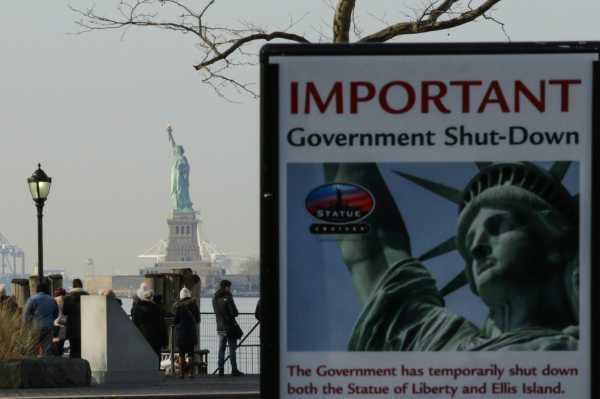
In the 1970s, the United States government began a unique practice of “shutting down,” or suspending most non-emergency government functions, when Congress fails to pass a spending bill to keep things running. Since then, there have been 20 shutdowns (two under Trump alone). They’re mostly brief, but always disruptive, and seem to be getting more frequent.
Usually, when the federal government shuts down or is on the verge of shutting down, the issue is resolved in the short term by passing a “continuing resolution” (or CR): a bill saying, basically, that the government should stay the course and keep spending what it’s been spending, maybe give or take a few minor tweaks. In the average year, CRs fund the government for 137.5 out of 365 days.
By extension, we could eliminate government shutdowns forever by enacting an automatic CR: a law that says that in the event that Congress fails to authorize funding for the government, things will just keep going along the way they’ve been.
This isn’t a purely hypothetical idea. In September 2013, just as the government was about to shut down, Congress passed and President Barack Obama signed an automatic CR that applied only to the US military. It was called the Pay Our Military Act, and it enabled the Defense Department to largely, though not entirely, avoid the worker furloughs and other cutbacks necessitated by the 2013 shutdown. The act applied only to that fiscal year, and congressional Democrats have since called for it to be revived.
If we want to eliminate furloughs entirely, and avoid semi-regularly throwing the personal finances of hundreds of thousands, if not millions, of government workers into turmoil, as well as the sundry other costs of government shutdowns, we should consider passing a permanent automatic CR that applies to the whole government, not just the military.
Shutdowns are a totally optional part of American government, just like disputes over increasing the debt ceiling. Eliminating the debt ceiling to avoid calamitous legislative showdowns over spending is a no-brainer. If done well, an automatic CR is worth adopting as well.
The pros and cons of eliminating shutdowns
Government shutdowns are bad.
They’re not “throw the entire global financial system into turmoil and risk a worldwide depression” bad, the way that debt ceiling fights are. But they’re bad. The Obama Office on Management and Budget estimated that the 2013 shutdown furloughed 850,000 employees at its peak; about 6.6 million employee-days were furloughed, in total. It hurt economic growth and job creation and cost the federal budget in the low billions of dollars.
Since the magnitudes of the effects on growth and the budget are relatively small, in the scheme of things, arguably the biggest harms of shutdowns are to furloughed workers. Many workers typically see their pay delayed for the duration of the shutdown and sometimes even longer than that.
While it’s normal for Congress to authorize back pay, that hardly makes up for the large disruption in cash flow for federal workers. “Essential employees” have to keep working even without pay for the shutdown’s duration.
Shutdowns quite literally turn federal civil servants, who do crucial work for modest pay (especially under budget sequestration and the current pay freeze), into pawns in congressional politics. They, more than anybody else, bear the cost of budget brinkmanship.
An automatic CR would end that victimization. It would ensure regular, reliable payment for civil servants and avoid these periodic disruptions of federal employees’ lives.
Not every automatic CR plan would be an improvement for federal workers, of course. One plan, proposed by Sen. Rob Portman (R-OH) during the 2013 showdown, would hold spending constantly for 120 days but then cut federal appropriations by 1 percent every 90 days thereafter. Barring active congressional intervention, this would cut trillions from the federal budget over time, and liberal budget watchdogs like the Center on Budget and Policy Priorities quite correctly opposed the idea. It would make federal employees worse off.
But a proposal that regularly increased appropriations using a formula tied to inflation or economic growth, to ensure federal agencies are not starved, would not have that flaw. It would be an acceptable alternative to the current cycle of budget standoffs. It would keep the government running indefinitely regardless of how responsible or irresponsible Congress chooses to be.
The idea is not without its pitfalls. Most critics of automatic CRs also oppose versions of the idea without automatic cuts. They worry that eliminating the potential for shutdowns would worsen an already dysfunctional appropriations process by lowering the stakes of failure, making it harder to raise funding for specific programs and improve program efficiency in the future.
This is a real concern that has to be weighed against the costs of frequent government shutdowns. In a world where shutdowns are genuinely rare, automatic CR opponents have the better of the argument. But shutdowns appear to be growing more frequent, and as tolerance of shutdowns increases, their value as a way to force new budget agreements deteriorates. As that process continues, the cost of automatic CRs, and the harm they do to the budget process, decreases.
It’s true that Congress could become neglectful of budget challenges under an automatic CR. But they have already done little to improve the miserable state of funding for non-defense discretionary programs.
It’s hard for me to imagine an automatic CR that automatically boosted spending making that problem worse. If anything, it would force conservative opponents of spending increases to the table and spur them to strike a deal reducing spending hikes in some areas in exchange for greater hikes where money is needed more.
This idea is, admittedly, somewhat fanciful in the Trump administration. The White House is certainly likelier to endorse a Portman-esque version of this idea, which would be a step backward, than a version that automatically boosts spending. And eliminating the debt ceiling is a much more important step than eliminating shutdowns.
But given Congress’s demonstrated inability to reliably keep the government funded, we should be thinking about ways to make the process more automatic and lower the costs of congressional dysfunction. A well-designed automatic CR would help.
Sourse: vox.com






